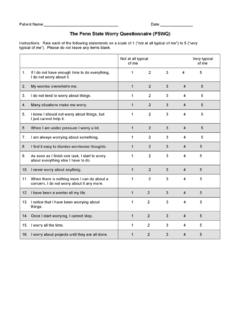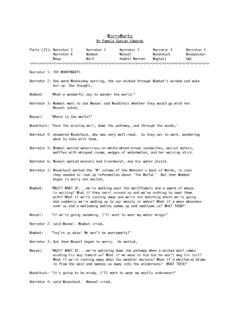Transcription of t} Ç DvP u v - TalkPlus
1 WorrLJ Ma age e t worry Management worry management is an intervention for the treatment of worry . This workbook can be used either alone or with the support of your Psychological Wellbeing Practitioner. How to use this workbook. worry management has four parts. Each aspect of worry management can be used individually to manage worries. It can take some time for an intervention to become effective and to show improvement. It is important to allow enough time for worry management to be effective. Helpful Resources; Help Guide Mind Shift App worry Management What is worry management? worry management is a set of techniques to help reduce the impact of worrying or to solve practical problems. worry management includes identifying and classifying worries initially then using either worry Time or Problem Solving to manage these. What is worry ? worry is a normal process that we all experience from time to time, however sometimes worry can become overwhelming and impact our ability to manage day to day.
2 There are several ways that worry is maintained, these include; 1. Avoidance or distraction As worry can be very distressing it is normal for us to avoid the things which are causing us to worry or try to distract ourselves from the worries in our minds. 2. Beliefs about worry : We may have certain beliefs about the function of worry ; that it is helpful or that it is making us ill. These beliefs can make it hard to stop worrying, or make the worry worse. 3. Putting things off Worrying can take up a lot of our time and is very distressing, therefore we might not have enough time or energy to tackle everyday problems. If this happens our problems can pile up and cause us even more worry . STEP ONE Classifying Worries There are two main types of worries; practical worries and hypothetical worries. Practical worries are often about a current situation that you can do something about. For example this can include things like; I don t have enough time to complete my work , I have a tooth ache or I need to book leave for my holiday.
3 It is quite normal when we are feeling anxious or overwhelmed not to act on our worries and to start putting things off. However this often leads to our worries piling up and we can become overwhelmed and stuck in a vicious cycle. Hypothetical worries are often about the future and what might happen. These worries are about things that we do not currently have control over and therefore cannot do anything about. Hypothetical worries often come in the form of a what if , for example; What if my car breaks down? , What if the train is late? or What if my daughter gets lost on her way home? . These worries can be very overwhelming and can lead to us worrying about worry ; that it is making us ill or wearing us Keeping a worry diary Initially it may be difficult to capture our worries as it is not something we do in our day to day lives. By using the technique below we can begin to identify the worries that are causing us to feel anxious.
4 When you notice you are anxious, some useful questions to ask yourself are; What do I think is going to happen? What is making me feel this way? What bad thing am I predicting? When you notice that you are feeling anxious try to identify any worries that may be in your mind. Using Worksheet 1 record the situation you were in, the worry or worries you had at that time and the emotion you were experiencing. Also record the intensity of the anxiety you were experiencing, from 0 100%. It is best to record the worries as soon as possible. Sometimes this may not be possible, for example if at work or out, however a phone or notepad can be used to jot down the thought until you can next access the worksheet. The last section of the worry Diary is to classify what type of worry you have written down, either hypothetical or practical. It may be difficult at first to decide what type of worry it is, it can be helpful to ask yourself; is there anything I can do to change this situation right now?
5 If so then the worry may be a practical one. By classifying our worries we can start to see which of our worries we can do something about, and which we need to let go. To complete Step 1 use Worksheet 1. Situaio WorrLJ I te sitLJ of A d ietLJ - % ClassifLJ P H WORKSHEET ONE worry Diary STEP TWO Managing worry Once you have kept a worry diary for a period of time and have got used to classifying your worries, the next step is to manage your worries. Use the flow chart below to decide which techniques would be most beneficial for you. Can you do something about your worry right now? Yes? Make an action plan to solve the worry . No? Use worry time to help let it go. If you notice in your worry diary that you have a lot of practical worries the best techniques might be to use Problem Solving. Problem Solving is helpful in order to create a manageable action plan to start solving the worries.
6 For Problem Solving see page 8. I f m a n y o f y o u r w o r r i e s a r e hypothetical, then Problem Solving would not be helpful. Instead the technique to use is worry Time to learn to let go of worries that you cannot do anything about. For worry Time see page 7. worry Time worry time is a set period of time each day allocated to worrying. worry time can be helpful in reducing the time we spend each day worrying, allowing us to enjoy our day to day lives. When we worry during the day, instead of focusing on these worry we postpone them for our allotted worry time. To do this follow the steps below; STEP ONE: Choose your worry time It is important to set aside, what you feel, would be a sufficient time each day for worry time, when you will not be interrupted or distracted. This time should ideally be in the evening, but not too close to bedtime, to mull over the days worries. It is important to stick to the same time each day in order to build a routine.
7 You may find that the more you use worry time the less time you need each day, then you can reduce your worry time accordingly. STEP TWO: Capture your worries When you notice that you are worrying during the day, write them down. You can either chose to still use the worry diary, a notepad or even your phone to do so. If the worry is a practical worry , use problem solving to solve it. If the worry is a hypothetical worry go to step 3 of worry time. If you find that you are worrying a lot at night it can be useful to keep your diary or a note pad near your bed. STEP THREE: Refocusing Once you have captured your hypothetical worry and written it down it is then important to refocus. This may sound difficult at first, but remember you will spend time worrying about it later, in your scheduled worry time, meanwhile, refocusing involves paying attention to the present. Pay attention to whatever task you were doing when the worry came into your mind.
8 Refocusing from our worries can be very difficult to do when we are not used to it, using our 5 senses can help us to do this. Concentrating on our sight, hearing, smell, touch and taste can help to ground ourselves in the present. For example, if you are doing something like the washing up focus on the scent of the bubbles, the temperature of the water or the sound of the splashing. Other ways to refocus might be to engage in a different task, such as cooking, reading a book or exercise. Some people find that listening to music is a good way to refocus, find whatever is best for you to be able to attend to the present. When further worries come into your mind through the day, repeat the process. Write the worry down and then refocus on the present. You might find the more you practise this the easier it becomes. worry Time STEP FOUR: worry time! When your worry time comes around, it is time to worry !
9 Get out the list of hypothetical worries you have written down during that day and select a worry to start to worry about. It is useful to ask your-self questions about each worry ; For each worry consider how you felt when you wrote the worry down and how you feel about it now, has this changed? Did the thing you were worrying about happen? If so, how did you cope? Are any of the worries no longer a problem? Would continuing to worrying about it during the day have made a difference? What could you be doing now instead of worrying?? Once you have done this for each of your worries and get to the end of the worry time it is important to stop worrying. You may find it helpful to destroy the list of worries rip them up or throw them away at the end of each worry time and start with a fresh sheet every day. As you practise this technique you may find that outside of your worry time you are more able to manage the worries.
10 As you progress with this technique you may find you are using less time than you originally thought each evening to worry . If this is the case you can reduce your allotted worry time in line with your current needs, you may find that eventually you don t need this time at all. Also as you progress you may find it is not necessary to write down your worries and you can refocus with-out this step. If this is the case then continue in this way. worry Write it down Refocus worry Time Problem Solving STEP ONE Identifying one problem It may be that you have more than one problem at a time, therefore the first step of Problem Solving is to choose one problem, perhaps start with the problem that will make the most difference if it was not there. It is important that we define the problem as clearly as possible, try to be clear about what aspects of the situation make it a problem. STEP TWO List all possible solutions List as many solutions as possible; don t worry about how practical, good or reasonable the solutions are at this stage, try for a list of at least five possible solutions.
![ZÀ]}µ o À }v - TalkPlus](/cache/preview/1/7/c/4/4/b/6/6/thumb-17c44b66edfab6bc2dc10c7f4bbf6249.jpg)










